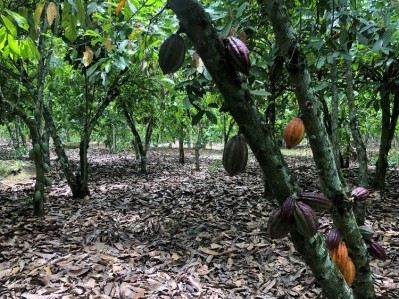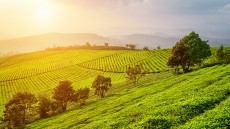OFI unveils first company-wide emissions targets: ‘It’s a stretch, but achievable’

In recent years, OFI (Olam Food Ingredients) has been setting individual emissions targets for some of its raw material products, but not all.
However today, the ingredients supplier is revealing a new, company-wide sustainability strategy. By 2030, OFI is committing to reduce Scope 1 and 2 emissions by a combined total of 50%, and Scope 3 emissions by 30% by 2030, all from a 2020 baseline.
For OFI – which sources, processes and sells agricultural commodities cocoa, coffee, dairy, nuts, and spices across 50 countries – Scope 3 emissions are the toughest to tackle. This challenge is reflected in its new target, according to the company’s head of sustainability impact Christopher Stewart, who tells us the new Scope 3 goal is a ‘stretch’, but achievable.
Scope 3: Which products have the toughest-to-budge emissions?
OFI is coining its first company-wide sustainability strategy ‘Choices for Change’. It’s made up of intermediary targets designed to put the company on track to achieve Net Zero by 2050.
Defining its Scope 3 emissions target was no mean feat, according to Stewart. “We have everything from annual row crops like onion, garlic, and chillies, through to shade tree crops like cocoa and coffee. The scope for reduction is different within the businesses.”
How close is OFI to achieving its 2030 emissions targets?
- By 2030, OFI wants to have reduced its Scope 3 emissions by 30% from a 2020 baseline. The company estimates it achieved a 13% reduction in Scope 3 emissions between 2022 and 2023.
- OFI has a combined Scope 1 and 2 emissions reduction target of -50% by 2030, with an intermediary target of more than -40% across Tier 1 operations by 2025. To date, a 27% reduction in Tier 1 operations has been achieved.
Although hesitant to pinpoint the crop with the hardest-to-reduce emissions, chief sustainability officer Roel Van Poppel reveals some are already faring better than others. It’s dependent on the type of supply chain, he explains. Scope 3 emissions for onion and garlic, for example, are ‘not the biggest’. For these crops, it’s not the cultivation itself but rather OFI’s drying and processing methods that account for the greatest greenhouse gas (GHG) emissions.
Crops associated with deforestation and land use change risk tell a different story. OFI works with several smallholder crops across the equator that fall into this category, from cocoa to coffee, and some nuts and spices.
How is OFI cutting emissions in coffee, cocoa, and other crops?
And within those smallholder crops, some emissions are easier to limit than others. Cashew, which is a tree crop, requires less fertiliser and other agricultural inputs, and is not considered energy intensive. Compared to other smallholder crops, the scope for emissions reduction is limited.
Cocoa, on the other hand, has more wiggle room. “Cocoa has a high land-use change legacy and therefore ending deforestation is the single most important thing the sector can do to bring down GHG emissions for cocoa,” sustainability impact lead Stewart tells FoodNavigator.

Other strategies for both cocoa and coffee include teaching farmers to prune their trees, which can have a ‘dramatic’ impact on yield with a ‘very small’ impact on GHG emissions. But encouraging adoption, particularly amongst older farmers, can be challenging.
“Many of the smallholders are older, very conservative, and may never have had training in good agricultural practices… They need to see [how these practices] work with their own eyes,” explains Stewart.
A benefit of OFI’s presence on the ground is that it can set up demonstration plots, whereby farmers volunteer to learn pruning and other agricultural practices. “They then become advocates within their own community because they see the [positive] impact it creates.
“It’s really about working socially with the farmers to achieve the practices that are going to move the needle.”
OFI estimates that through the adoption of such practices, yield can be increased alongside an emission reduction of between 30-60%.

And actually across the board, that’s a strategy that appears to be paying off. “One of the most effective ways you can reduce GHG emissions overall, and GHG per tonne, is by helping farmers to increase their yield,” says Stewart. Even if that means encouraging emission-intensive nitrogen fertiliser use, overall emission reduction is still achieved.
“We are now doing a lot of interesting work on low-emission, slow-release fertilisers that optimise the way nitrogen is taken up by the plant, meaning less turns into nitrous oxides and other potent greenhouse gases.”
Will OFI lean on carbon credits to achieve its Scope 3 emissions goal?
OFI plans to submit its new environmental targets to the Science Based Target Initiative (SBTi) at the end of the year.
Earlier this year, SBTi released plans for a ‘major revision’ of its Corporate Net-Zero Standard, which could see companies use voluntary carbon credits to achieve Net Zero status. The plans caused widespread controversy, with SBTi employees calling for the CEO’s resignation.
But for industry, the possibility of using carbon credits to help offset emissions and achieve Net Zero status is considered a win. That’s not to say that all emissions will be offset.
“Our focus has very much been on the reduction side,” explains Stewart. “We’re reducing within the supply chain and want our customers to come with us on that journey.”
But once sizeable reductions have been achieved, OFI does see ‘significant’ potential in further cutting GHGs within different landscapes, from restoring forests to water catchment areas. “It might be that carbon credits are part of that story.”
OFI ramps up regenerative agriculture rollout
Another major commitment within OFI’s Choices for Change strategy is to bring one million farmers, and two million hectares of land, under regenerative farming practices. If achieved, that would account for roughly 40-45% of the company’s current supply.
What does 'regenerative agriculture' mean to OFI?
No official EU-wide definition of regenerative agriculture exists. But for OFI, regenerative agriculture means an approach to farming that improves farmer livelihoods and resilience by ending harmful and destructive practices, optimising inputs, and working with nature to restore and enhance soil health, water, biodiversity and climate on and around farms.
As it stands, OFI estimates that supported farmers manage around 1.5m hectares within its supply chain. The ingredients company has six years to bring another 500,000 farmers onboard and embed regenerative agriculture in its support programmes.
Of course measuring the extent to which these practices have been adopted can be a challenge. The company classes regenerative agriculture commitment into three categories: bronze (whereby destructive practices are minimised), silver (favouring restoration), and gold standard.
“We’re aiming for two million hectares to be working to silver or gold standards,” explains the CSO.
Balancing ‘trade-offs’ with sustainability wins
Choices for Change is not focused on environmental sustainability alone, and OFI stresses that all three prongs of sustainability – people, planet, and profit – are inherently linked.
By 2030, the ingredients supplier wants to ensure one million farmers receive enhanced livelihood support (currently 499,000 received enhanced livelihood support), and that 200,000 are elevated to living income level (currently more than 50,000 receive living income in coffee and cocoa).
“We believe that it starts there,” says Van Poppel. “If a smallholder farmer earns a living income, he can provide for his family, he can make sure his kids go to school, he can save money, he can provide money for clothes, housing and healthcare. So achieving that level is crucial.”
At the same time, it’s important smallholder farmers feel supported in moving towards sustainable practices for long-term food security. This is of particular importance in places like Africa, where OFI is observing increased competition from other industries, such as mining.
“There is a longer-term security of supply element that we feel is a fundamental risk to many of the crops we’re operating in. That’s why we feel the social and economic aspects of sustainability are so important; you cannot see them as separate from environmental sustainability.”

While there are obvious sustainability wins to be made, some come with trade-offs. Implementing good agricultural practices doesn’t come cheap, and that’s likely the biggest trade-off for OFI. “You have to have significant resources in the field to provide training and reach farmers who have difficulty accessing finance, agricultural inputs and so forth,” explains OFI’s Stewart.
“That means we have to have high ambitions, but also need other stakeholders come with us [on the journey] and be prepared to share the costs of implementing such programmes.”





















